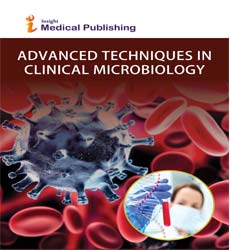The Development of Sensitive Diagnostic Tests Zoonotic Infectious Diseases Hanta Viruses
Scott Parrott*
Department of Microbiology, Kyoto University, japan
- Corresponding Author:
- Scott Parrott
Department of Microbiology
Kyoto University, japan
E-mail: Scott@Parrott.jp
Received Date: December 08, 2021; Accepted Date: December 22, 2021; Published Date: December 29, 2021
Citation: Parrott S (2021) The Development of Sensitive Diagnostic Tests Zoonotic Infectious Diseases Hanta Viruses. Adv Tech Clin Microbiol. Vol.3 No.3:115
Copyright: © 2021 Parrott S. This is an open-access article distributed under the terms of the Creative Commons Attribution License, which permits unrestricted use, distribution, and reproduction in any medium, provided the original author and source are credited.
Introduction
Predators can directly and indirectly influence reservoirpathogen interactions by intense infected individuals, by removing infectious pathogens stages and by propelling reservoir traits. It is vital to spotlight interactions over several organic process levels joined to predation and organism transmission to know hanta virus dynamics in “degraded” systems [1]. Domestic dogs and cats area unit the species most closely related to humans, and consequently area unit the foremost exuberant and widespread carnivorous mammals inside the globe. It is vital to spotlight interactions over several organic process levels joined to predation and organism transmission to know hanta virus dynamics in “degraded” systems.
The pathologic process of hanta virus infections is unclear as there is a deficiency of animal models to clarify it (rats and mice do not seem to amass severe disease). Whereas the primary web site of infective agent replication inside the body is not illustrious, in HFRS the foremost impact is inside the blood vessels whereas in HPS most symptoms area unit associated with the lungs. In HFRS, there is accumulated tube consistence and attenuated force per unit area due to epithelial tissue pathology and so the foremost dramatic hurt is seen inside the kidneys, whereas in HPS, the lungs, spleen, and gall bladder area unit most affected [2]. Early symptoms of HPS tend to gift equally to the respiratory disorder (muscle aches, fever and fatigue) and often appear around 2 to a few weeks once exposure.
Later stages of the downside about four to 10 days once symptoms start embody problem respiration, shortness of breath and coughing. These cells modify infective agent replication that activates the system, not ably macrophages and CD8 T cells. It has been demonstrated that in cells infected with unhealthful hantaviruses, a form of antiviral response is delayed, resulting in accumulated infective agent titers Antiviral innate immune response inflammatory cytokines and chemokine’s are going to be an ambiguous arm [3]. Every DOBV- and PUUV-infected patients had elevated levels of interleukin-10, interferon-g, and tumors gangrene factor-a in their humor samples. patients with an additional severe clinical course of the health problem had considerably higher levels of interleukin-10 and tumor gangrene factor-a to avoid harmful over association, the fluid and balance, what is more as circulatory volume, ought to be strictly managed in step with the patient's fluid standing, amount of symptom, and internal organ perform for patients that area unit noble metal and with leaky capillaries [4].
Hantavirus infections area unit a form of disease that is becoming heaps of common. The understanding and detection of Hantavirus infection has vastly advanced throughout the previous number of decades all around the world. The frequency and size of Hantavirus epidemics are growing. Higher clinical awareness, the event of sensitive diagnostic tests, exhaustive reservoir analysis, and propelling climatic circumstances may all be activating factors. DNA vaccines have the advantage of being straightforward to form multivalent vaccinations and inflicting long humeral and cellular immunity. Inside the U.S an antigen supported degree M part sort of HTN and PUUV is presently undergoing phase I in clinical trial, phase I clinical test, clinical trial clinical studies to see safety, tolerability, and immunogenicity [5].
References
- Richmond JK, Baglole DJ (2003) Lassa fever: epidemiology, clinical features, and social consequences. BMJ 327: 1271-75.
- Ogbu O, Ajuluchukwu E, Uneke CJ (2007) Lassa fever in West African sub-region: an overview. J Vector Borne Dis. 44: 1-11.
- Lassa fever and global health security (2018) Lancet Infect Dis 18: 357.
- Ahor DE, Erah A, Agba IM, Oviasogie FE, Ehiaghe AF, et al. (2017) Prevalence of Lassa virus among rodents trapped in three South-South States of Nigeria. J Vector Borne Dis 54: 146-50.
- Hamblion EL, Raftery P, Wendland A, Dweh E, Williams GS, et al. (2017) The challenges of detecting and responding to a Lassa fever outbreak in an Ebola-affected setting. Int J Infect Dis 66: 65-73.
Open Access Journals
- Aquaculture & Veterinary Science
- Chemistry & Chemical Sciences
- Clinical Sciences
- Engineering
- General Science
- Genetics & Molecular Biology
- Health Care & Nursing
- Immunology & Microbiology
- Materials Science
- Mathematics & Physics
- Medical Sciences
- Neurology & Psychiatry
- Oncology & Cancer Science
- Pharmaceutical Sciences
